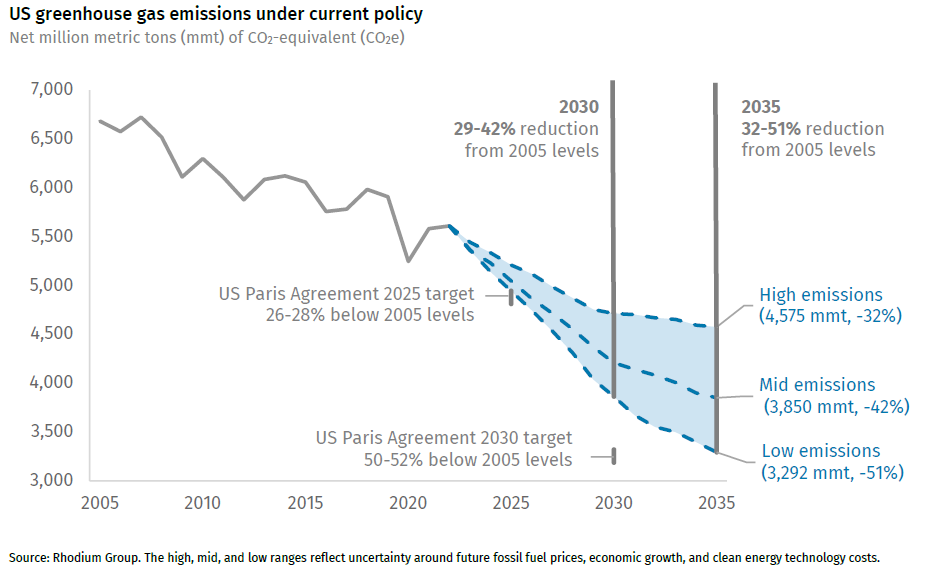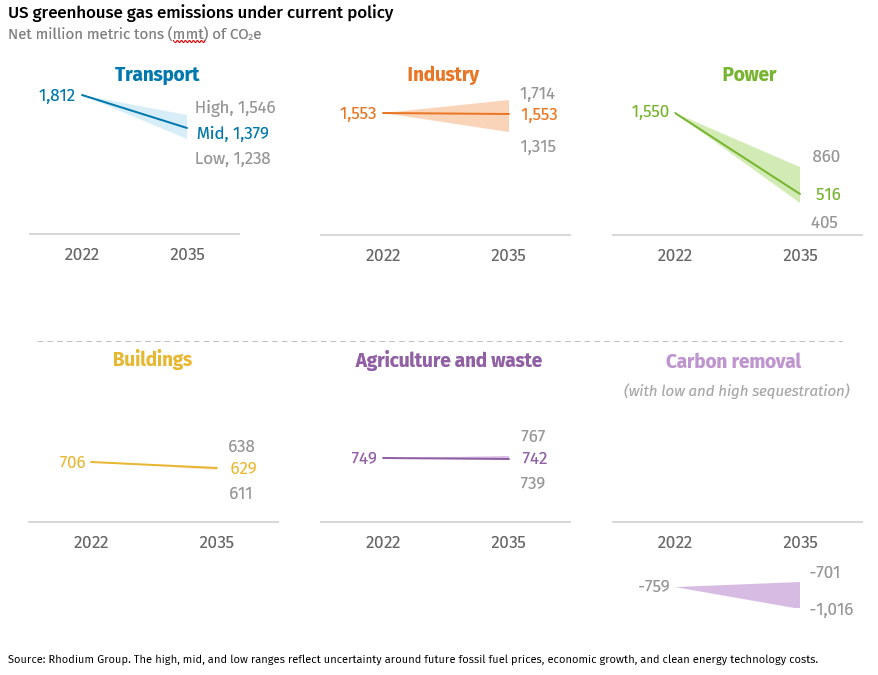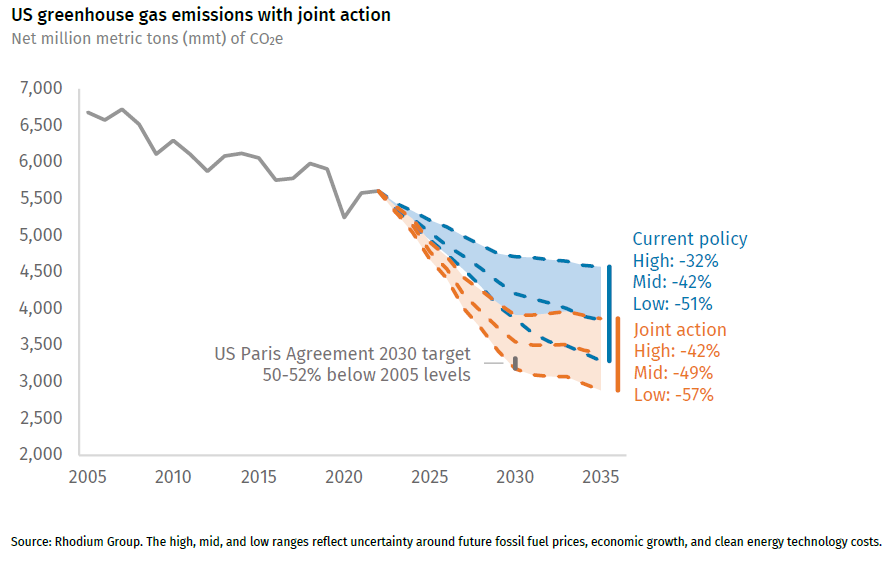Taking Stock 2023: US Emissions Projections after the Inflation Reduction Act
In our annually updated outlook for US greenhouse gas emissions under current federal and state policy, we find that the US is on track to reduce emissions 29-42% below 2005 levels by 2030, absent any additional new action.
Every year, Rhodium Group provides an independent projection of future US greenhouse gas (GHG) emissions, under current policy and expectations for economic growth, future fossil fuel prices, and clean energy cost and performance trends. This year, the ninth edition of our annual Taking Stock report, the current policy baseline we model includes something different than the last eight reports: meaningful congressional action on climate change in the form of the Inflation Reduction Act (IRA). We’ve quantified the effect of the IRA in previous work, but this is the first time major federal climate legislation is incorporated into Taking Stock.
The full suite of current policies on the books as of June 2023 drives US emissions to 32-51% below 2005 levels in 2035. Along the way, the US will achieve a 29-42% reduction in GHGs in 2030—a meaningful departure from previous years’ expectations for the US emissions trajectory but not enough for the US to meet its pledge under the Paris Agreement to reduce emissions by 50-52% below 2005 levels by 2030. The difference between our estimate’s low and high ends is primarily driven by faster economic growth, cheaper fossil fuels, and more expensive clean energy technologies.
Today, nearly one year after Congress passed and President Biden signed the IRA, its effects on the US’s path to decarbonization are coming into clearer focus. We have more signals on how federal agencies plan to implement key aspects of the law, including tax credit provisions for clean electricity and clean vehicles—two major sources of emissions abatement. We’ve also seen markets and supply chains begin to respond to the incentives the law puts in place, and we incorporate the latest cost and performance projections for wind, solar, electric vehicle batteries, and a range of other clean energy technologies to reflect these responses.
With the IRA in place, the power and transportation sectors continue to see the largest declines in GHG emissions relative to today, as detailed in Chapter 3 of the full report. The power sector in particular looks quite different in 2035 compared to today, with zero- and low-emitting power plants making up 63-87% of all generation that year, up from around 40% in 2022. Electric vehicles also continue their rapid growth, and, taken together, this progress on decarbonization also reduces household energy bills by an average of $2,200-$2,400 per year in 2035 from 2022 levels.
But challenges remain in achieving these outcomes, especially a massive build-out of new infrastructure. In the power sector, for example, the US needs to add 32-92 gigawatts (GW) of wind and solar on average every year from now until 2035 to achieve these ambitious results. For comparison, adding 32 GW of renewables is roughly equivalent to the best year of renewable installations on record, and adding 92 GW is triple the best year on record. This level of deployment faces headwinds in nearly every direction, meaning more work is likely needed to address supply chain constraints, transmission, interconnection, and siting issues, and a growing need for a qualified workforce—to name a few hurdles.
In the vein of additional policy action, in this year’s Taking Stock, we also update our look at what other policies are required for the US to achieve its 2030 target under the Paris Agreement. Our previous Pathways to Paris reports quantified the impacts of a set of additional steps that all levels of government need to take to push US emissions to 50% below 2005 levels in 2030. In this report, we update key components of some of those policies to reflect the latest proposals from the federal government, and we find that reductions of 41-52% below 2005 levels are still possible—putting the 2030 Paris target within reach—but getting there won’t be easy. Federal actions that the Biden administration can take unilaterally and that can be achieved in the president’s first term only yield GHG reductions of 37-49% below 2005 levels, leaving the 2030 target out of reach. While critical, these federal regulatory policies will need to be paired with ambitious state actions. The IRA is the most substantial federal action the US has ever taken to combat climate change, but it was not intended to solve every decarbonization challenge in one bill. A sustained stream of federal and state actions is the only way to close the US emissions gap. While there is more activity at all levels of government than ever, the ramp-up of policy action required in the years ahead will be a substantial lift above and beyond the unprecedented actions of late.
In the first two chapters of Taking Stock 2023, we account for changes in policy and energy market & economic conditions since last year’s edition. Chapter 3 shares our new projections under current policy, including key trends by sector, and in Chapter 4 we assess the path to the 2030 Paris Agreement target. As in years past, we provide our emissions projections at the 50-state level in all emitting sectors of the economy for all greenhouse gases for the three main emissions scenarios. This detailed data is available on the ClimateDeck, a partnership between Rhodium Group and Breakthrough Energy.


